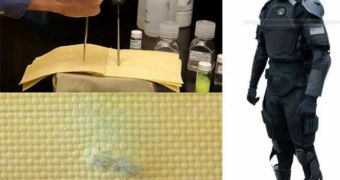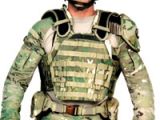The basic idea behind body armor hasn't changed very much for the past few thousands years.
The main purpose of the armor is to stop weapons or projectiles from penetrating a person's body and to diffuse the weapon's impulse energy, so that the final impact causes little or no damage at all.
Although not effective in absolutely every situation, armor can generally help protect people from serious injuries or death, being effective especially against the right weaponry.
As time passed and battle tactics and weapons improved, people had to develop stronger and more advanced armor to protect against increasingly sophisticated weapons. However, despite these improvements, today's body armor still possesses some of the same shortcomings as the ancient ones.
Whether made from overlapping metal plates or layers of fabric, armor is often heavy, bulky and rigid, therefore impractical for use on arms, legs and neck. That's why medieval suits of plate metal had gaps and joints to allow people to move around, and the body armor used today often protects only the head and torso.
In the near future, this game of cat and mouse between armor and weapon is about to take an unexpected twist: liquid armor.
No, the soldier of the future will not exactly be swimming in his suit, but mixing fluids into the Kevlar vests could be the answer to some of today's problems.
There are two ways of doing this. The first is a shear-thickening fluid (STF), which behaves like a solid when it encounters mechanical stress or shear. It contains liquid polyethylene-glycol and nano-particles of silica. In other words, it moves like a liquid until an object strikes or agitates it forcefully. Then, it hardens in a few milliseconds.
The other fluid that can reinforce Kevlar armor is magnetorheological (MR) fluid. MR fluids are oils that are filled with iron particles. When exposed to a magnetic field, the particles line up, thickening the fluid dramatically. The hardening process takes also around twenty thousands of a second.
With the right combination of density, particle shape and field strength, MR fluid can change from a liquid to a thick solid.
As with shear-thickening fluid, this change could dramatically increase the strength of a piece of armor. The trick is to activate the fluid's change of state.
Since magnets large enough to affect an entire suit would be heavy and impractical to carry around, researchers propose creating tiny circuits running throughout the armor.
In addition to making stronger, lighter, more flexible armor, fabrics treated with shear-thickening and magnetorheological fluids could have other uses as well. For example, such materials could create bomb blankets that are easy to fold and carry and can still protect innocent bystanders from explosion and shrapnel.
Treated jump boots could harden on impact or when activated, protect the paratroopers' boots.
Prison guards uniforms could make extensive use of liquid armor technology, especially since the weapons guards are most likely to encounter are blunt objects and homemade blades.
Unfortunately, neither type of armor is quite ready for battlefield use. STF-treated Kevlar armor could be available by the end of 2007 - beginning of 2008, and MR fluid may require another 5 to 10 years of development before it can be worn by troops.

 14 DAY TRIAL //
14 DAY TRIAL // 
